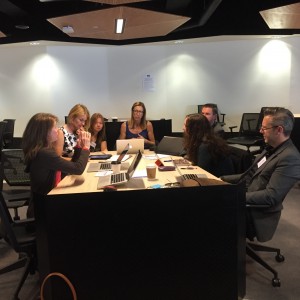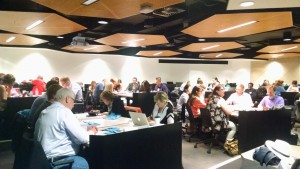by Diane K. Angell, St. Olaf College
We have all likely shared the experience, early in our teaching career, of a gaggle of students gathering at our office door after an exam. “I studied for so many hours!” “I came to class everyday.” “I always did well in high school.” Students also seemed to struggle ahead of exams as they tried to learn and master scientific material. “What should I study?” “Why can’t you just give us a study guide?” I was often perplexed by these frustrations. I wondered and tried to recall how I had learned material and strategized as a science student preparing for the inevitable exams in larger introductory college courses.
That same month, I found myself at a conference, the Accredited Colleges of the Midwest’s Teagle Collegium on Student Learning. The focus was very much on metacognition. Although as a biologist, I struggled to understand the details of several presentations, it all sounded very familiar. Perhaps this was what my students were missing? I appreciated the intellectual points and took copious notes, until my mind began to wander. I needed to prepare to host a large group for Thanksgiving in the coming days. How should I start? What did I need to purchase and where would I get it? What needed to be prepared and cooked when, so that all the different dishes were ready and warm when it was actually time to sit down and eat? I began to get anxious. I quickly realized two things. Focusing back on my students, I immediately appreciated the degree to which preparing a Thanksgiving meal, and preparing to take an exam are both complex metacognitive tasks. I could finally imagine what my students were feeling and understand the metacognitive challenges exams present to them. Students need to evaluate what they know, what they don’t know and how best to approach any material they are uncertain of. And unlike cooking and meal preparation, there are no clear simple sets of directions highlighting how to approach the task of taking a typical college classroom exam. Second, my own pre-Thanksgiving meal mental preparation check made me realize that I have likely been using such metacognitive skills since I was a student, but was just not aware I was using them. Perhaps I did have some wisdom to share and upon returning to campus I committed to using a metacognition approach to help students prepare for exams.
Introductory college biology courses are an excellent place to begin engaging students with a metacognitive approach to exam preparation. These classes will probably always have exams. Moreover, as students move on in biology they are likely to face even more challenging exams. In order to engage students in metacognitive practices I came up with a series of straightforward metacognitive prompts that I emailed to students before each exam. They included simple questions such as: How do you think you will start studying? What techniques will you use while studying? What was the most difficult topic in this section of the course and why was it difficult? How will you approach the material you do not yet understand?
I found their responses fascinating. Some clearly wrote as little as possible, but most wrote quite extensively sharing with me precise details of how they had studied (or not studied) to prepare for the exam. Many responses were surprisingly sincere and confessional. The assignments brought home to me two points that have left a lasting impression. First, I was reminded of the importance of establishing a connection with students as well as the importance of that connection to student learning. Their emailed responses helped me get to know them in a way that was very different than in the public arena of class or lab. They let me in on their personal narrative of test preparation. I sometimes felt as if I was reading a secret diary. They were honest with me in their emails about what their studying experiences had been, perhaps even more so than if they had come to see me in person. Perhaps the proliferation of email, texting and Facebook has made students more comfortable conversing through a keyboard with faculty than face to face. After responding to the emailed questions, many did eventually come in to chat and engage with me about study strategies and differences they were noticing between high school and college. They seemed to think they knew me better and that I knew them better. Upon arriving in my office, they would frequently refer back to their emailed responses, even though I sometimes struggled to remember exactly who had emailed me what details. The emails seemed to prompt a unique relationship and they saw me as someone who was interested in them as an individual, an attitude that likely helped them feel as if they were part of the learning community in the classroom.
I also came to understand that that the task of mastering material in order to prepare for an exam has become more complicated. In the past, we had a textbook and we had notes from class. That was it. Today this task really is fraught with complex decisions. Students in college classrooms are less likely to be taking notes in a traditional lecture format. They are more likely to be engaged during class in small group discussions and problem based learning activities. They have access to and are justly encouraged to use the online resources that come with texts and take advantage of other online resources. They are also frequently encouraged to form study groups to discuss their understanding of topics outside of class. These are great ways for students to engage with material, and prepare for exams. This diverse learning landscape can be a lifesaver for some students, but for others, when it comes time to prepare for an exam, the variety of options for studying can be overwhelming and paralyzing. As we have opened up new ways of teaching and learning, we may have left students with many different resources at their fingertips but failed to help them think metacognitively about what works for them as they master knowledge to prepare for a summative exam.
Both the stronger connections I made with my students and my better understanding of the diverse exam preparation choices they must make help me feel better prepared to mentor and advise students as they navigate their introductory biology course. By engaging students metacognitively in emails concerning their exam preparation I gained a deeper understanding about how students were learning in my class. Their sincere and thoughtful responses provided a window on their world and, in interesting ways, their metacognitive thoughts rounded out my efforts to metacognitively assess my course. As faculty, we are often reminded to step back and reflect on our goals for our class and for student learning. We need to consider what is working in our course and what is not working. It was finally clear to me that a full metacognitive consideration of my course required regular reflective feedback from my students and an understanding of what they were struggling with. Although I had always solicited such feedback, students seemed much more likely to be thinking about their learning and willing to share their assessment of that learning in an email just before an exam. Ultimately I now see their honest metacognitive feedback has meant that I have gained as much or more than the students I was initially trying to help.
Connecting with students can improve student performance Share on X

